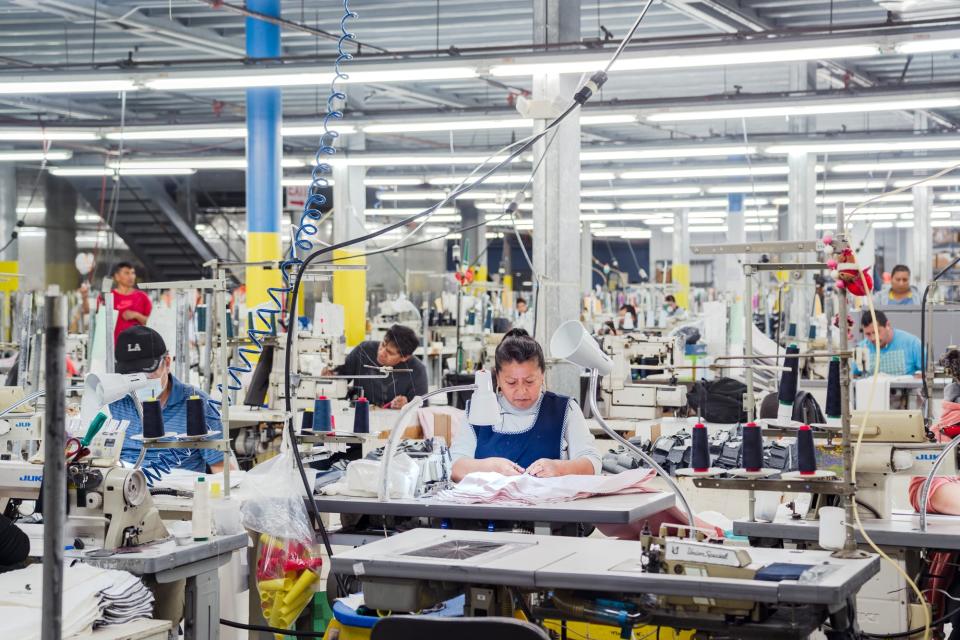Denim Is Destroying the Planet
Jeans are the consummate wardrobe workhorse, an indispensable staple found (usually in multiples) in practically every person’s closet. They’re also one of the fashion industry’s worst offenders of environmental damage. Manufacturing those beloved blues uses massive amounts of water. While the figures vary slightly depending on whom you ask, it takes 998.8 gallons of water to produce one pair of jeans (the equivalent of three days of water usage for a U.S. household) according to Levi’s. Brands like Reformation and Warp + Weft place it even higher, at 1,500 gallons per pair. Either way, it’s a hell of a lot of a precious, rapidly dwindling natural resource sucked up by a single pair of pants.
And the denim-making process has been tricky to evolve because it’s “an extremely complex, opaque supply chain, with five suppliers, and the brand’s often not playing a role beyond just being a buyer,” explains Katrin Ley, managing director of Fashion for Good, an organization working to make fashion more sustainable. “So creating change on, for instance, dyeing and finishing, that’s your second or third [step of the supply chain], and it’s often harder to directly connect with.” In other words, the brands have been able to wash their hands of whatever goes on in the process. Thankfully, some companies are making significant efforts to curb water waste (while addressing energy use and chemical pollution) — saving the planet, and the world’s favorite textile, in one fell swoop.
What’s so bad about denim?
The H2O-guzzling damages of your jeans begin with the fabric itself. “Cotton is just a very thirsty plant,” says Ley, adding that growing the plant alone accounts for 68 percent of denim’s total water footprint (and consumers laundering their own jeans make up 23 percent). Timo Rissanen, assistant professor of fashion design and sustainability at Parsons, who holds a PhD in zero waste fashion design and has co-authored two books about fashion and sustainability, says the farming methods (pesticides, fertilizers), even location and water source impact how eco-unfriendly cotton growing can be. But, Ley adds, even “compared to other cotton products, denim is very water intensive.” For instance, a cotton T-shirt needs 713 gallons of water to produce.
One difference in denim is the finishing, explains Emma Scarf, an analyst at Fashion for Good. “It’s fashionable these days to have a very soft, vintage-look denim rather than raw denim, so much denim goes through an acid wash, stone wash, or mill wash,” all of which are “very water-intensive” processes. For example vat-dyeing, which is the process traditionally used to apply indigo color to the fiber, has to be done three to four times for that delicious shade of blue to stick.
And according to Mostafiz Uddin, managing director of Denim Expert Ltd. and CEO of Bangladesh Denim Expo, “it’s not just the large quantity of water used — the fading process in denims also consume chemicals which are harmful for the workers and also the environment, and chemicals which are not carefully selected don’t degrade, and have long-lasting impacts.” (Those impacts are horrifyingly clear in the 2014 documentary RiverBlue, exploring extreme pollution of the world’s rivers by fashion manufacturing, denim specifically.)
Turning this damaging production process planet-friendly is prohibitively expensive. “Who’s taking on those investments? A new dyeing and finishing machine can easily go into $500,000 to $1 million, and it might not necessarily be an incentive for the mill operator or dye house operator to invest in those new products,” Ley says. “Water doesn’t have a price.” She notes this lack of incentive may be why progress in the industry seems glacial, specifically for brands without their own facilities.
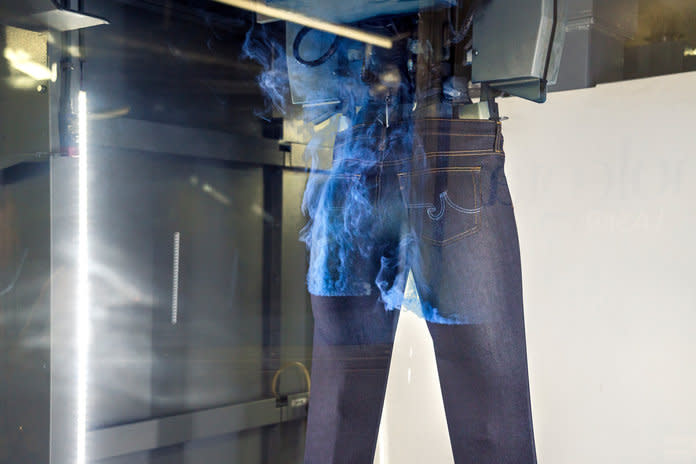
An inside look at AG Jeans' dyeing process.
|Philip Cheung
Some brands are breaking away from denim’s destructive past.
AG Jeans, a premium denim player launched in 2000, has continually revamped its manufacturing. “We’ve slowly taken steps to implement a more sustainable, efficient business approach, in terms of how we wash jeans and how much energy and water we consume,” says Zihaad Wells, VP of design at AG. These sustainability changes started back in 2010, with the addition of ozone technology, followed by new washing machines, and then new dryers in 2014, adding solar panels to its factories in 2016, and using laser finishing machines starting in 2017. A shiny new filtration system in the brand’s California-based facility (photographed in this article) has raised the stakes for all denim brands seeking to minimize water usage.
“We’d already started to recycle some of our water, but it wasn’t enough — we wanted to recycle as close to 100 percent as we could possibly get,” explains Wells, ultimately landing at roughly 99.7 percent recycled water thanks to the filtration system. AG’s washers spray water instead of dumping it into machines, and Wells explains the dyeing machines “extract the loose indigo as opposed to trying to wash it all out.” As for the finishing: the jeans’ glorious fading, creasing, artful holes and battered hems come from lasers — a water-free process, unlike your typical stone washing or sanding. Thus, AG has reduced its factories’ entire daily water waste to just 1,200 gallons (which is due to unavoidable evaporation and minor spillage, Wells explains), versus 380,000 gallons per day that a traditional denim factory uses. “Typically in this industry, the thousands of gallons of water used in creating denim will get dumped back into the environment,” Wells says; this new system avoids that.
Water conservation is just one way the brand’s shrunken its consumption. Their dryers are topped with metal boxes “that basically ‘traps’ the hot air and puts it back into the machines,” Wells explains, saving 50 percent of heat normally used. And denim scraps from the cutting room floor are reused for building materials.
“Our sustainable approach wasn’t about creating a one-time gimmick, it was about looking at the business and saying, ‘How can we be much more efficient and responsible with our approach to the precious resources of water and energy that we have, in our everyday practices?’” This was possible, in part, because instead of working with outside suppliers, AG operates its own facilities. Millions of dollars have been invested in these changes, per Wells, who says they’re just the start. “We’re not done by any means, these are just the first steps we’ve taken to creating a much more sustainable process.”
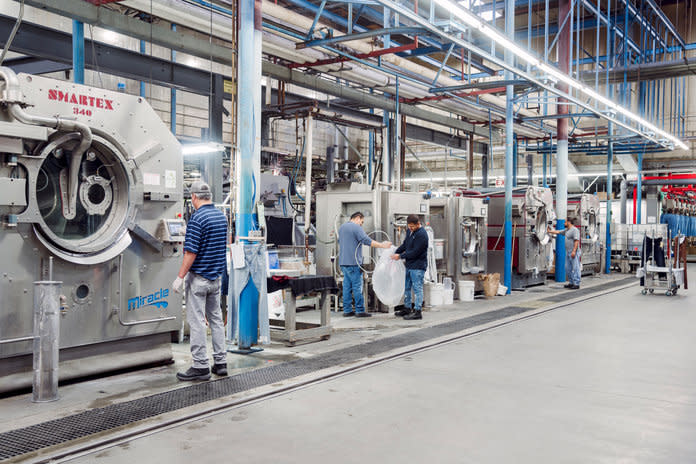
Workers in AG's state-of-the-art facility in California.
|Philip Cheung
Relative denim newcomer Warp + Weft also owns and operates its factories and has made sustainability a priority. Since its 2017 launch, the L.A.-based brand has produced jeans using just 10 gallons of water per pair, and 98 percent of that paltry amount is recycled at its own water treatment plant. Its jeans also use half the amount of dye and energy as traditional denim, thanks to ultra-absorbent Tencel in its fibers (also made in-house) and up-cycled plastic and old denim; while finishing is done via waterless Dry Ozone (aka oxygen) technology, replacing bleach.
“The competitive advantage we have is that we craft our own fibers; weave, wash, and stitch the fabric; water treatment and recycle the water — all in the same facility,” says the brand’s founder, Sarah Ahmed. “When you have everything in one plant, you have a level of control, which we use to our advantage.” Denim is the family business: “I come from a manufacturing background, and am from Pakistan, which produces one-third of the world’s denim, and my family produces some of that,” through Artistic Milliners, a denim producer dating back nearly 70 years.
The Ahmeds also started premium denim label DL1961 in 2008, jeans Ahmed says are sustainable on the down-low. “We felt there wasn’t enough awareness for that to be a selling- or feeling-point for the customer,” she says. “I was really frustrated with all of that, so I thought the best way to do it was direct-to-consumer, control the language, and create a brand based on sustainability, inclusivity, and affordability,” and that became Warp + Weft. (Sizing ranges from 00 to 24 for women, there are in-between sizes for men, and kid’s pairs, too, while prices range from $68 to $98, half the cost of high-end styles.)
“We’re obviously already dedicated to producing denim sustainably and responsibly, but now we also want to be the leaders of water giving in retail, which doesn’t really exist,” she says. So Warp + Weft has partnered with Charity: Water to provide a lifetime supply of water for 3,300 people for each pair of jeans sold, at first in Malawi, and then elsewhere. It launches on the brand’s second birthday, May 16.
In those two years, Warp + Weft has sold around 477,000 pairs of jeans in total, saving 572.4 million gallons of water, “and that really means there’s a customer out there,” Ahmed says. As for why the brand launched with so many messages, of sustainability, inclusivity, and affordability? “Well, it’s about time a brand embodied all these things — at baseline,” she explains.
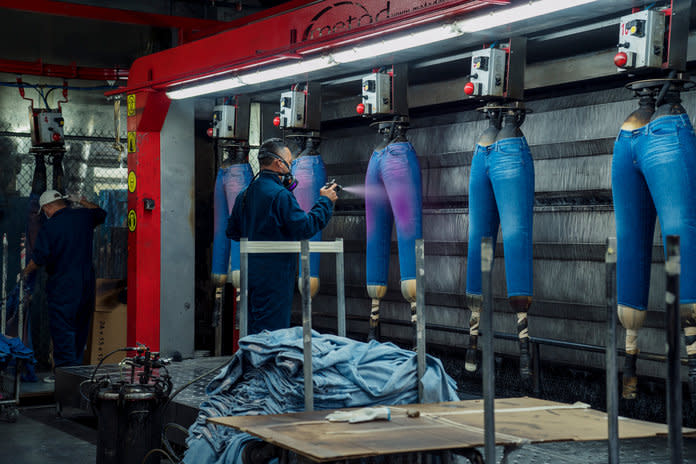
Spraying, rather than vat-soaking, dye.
|Philip Cheung
No brand has done quite as much to make environmentally kinder jeans than Levi Strauss & Co., a label that’s globally synonymous with jeans, like Kleenex is to tissues or Band-Aid is to bandages. The company started tracking resource use and waste in its production decades ago. “In 1995, we were the first apparel company to establish strict water quality standards for suppliers,” explains Paul Dillinger, head of global product innovation at Levi's. In 2011, it launched Water>Less, a line with 20-plus water-conserving production techniques. (For example, using a thimble of water and ozone instead of detergent; tumbling jeans with bottle caps and golf balls, not fabric softener; water-free stone washes; combining multiple wet cycle processes.) Then, in 2014, Levi’s figured out how to use 100 percent recycled water in parts of its jeans production (an industry first). By 2017, 55 percent of all Levi’s jeans were produced with Water>Less practices, and the goal is for 80 percent to be by 2020. This has saved over 3 billion liters of water, including 30 million liters of fresh water saved through recycling — and the brand open-sourced its water saving strategies, almost challenging competitors to be as savvy.
Next, Levi’s turned its attention to a more earth-friendly fiber: hemp. “The environmental benefits and tremendous water savings associated with hemp cultivation are well known, but fabrics made with hemp fiber blends have always been coarse, rough, and a lot less comfortable than cotton,” Dillinger says. “We’ve made a hemp-blended denim that looks and feels as good as cotton — maybe even better,” he says. The end product uses an estimated 821 liters less fresh water than a traditional pair of jeans. All of this work has gotten Levi’s noticed by the experts.
“Levi’s has been around for a long, long time and is massive — and they’re taking [sustainability] on; they still have a ton to do, no doubt, both from environmental and social aspects, but they are genuinely talking about it internally, much more than publicly, and that makes me hopeful,” Rissanen says. “If an industry leader like Levi’s is grappling with it, then I think systemic change is possible in the longer term.”
Perhaps that can be seen with Reformation, which has promised ethical, sustainable clothing since launching in 2009, and expanded to denim with Ref Jeans in 2017. According to the brand, each pair uses just 200 gallons of water to make. (While saving over 80 percent of material waste, and more than 70 percent of CO2 emissions compared to a typical pair of jeans.) “We all wear denim: It's one of the mainstays of most of our closets, and we don't expect that to change — so we wanted to tackle it head-on,” says Reformation’s founder, Yael Aflalo. “Unfortunately, denim is pretty much the worst clothing for the environment,” she notes, adding it was a “no-brainer” to develop jeans that don’t assault the planet. Another bright spot of the Ref line? “Limiting the amount of steps, chemicals, energy, and water usage actually makes the jeans more affordable by reducing costs at the fabric and manufacturing level,” Aflalo says. The pants are priced at $98 to $148.
RELATED: These Are the Only Spring Denim Trends Worth Buying This Year
Her brand eschews non-chlorine-based bleaches, and traditional dyes for enzyme processes that she says reduce the water- and energy-usage by two-thirds. Plus, “People, not machines, do our hand-sanding techniques that give the worn-in look of whiskers, thigh wear, butt wear, and destruction holes,” she says. Scarf predicts enzyme dyeing and foam dyeing are coming soon to more brands you know and love. For example, Lee and Wrangler, both owned by VF Corporation, which Ley adds have “been very active in developing foam-dyeing technology.”
British denim brand M.i.h. Jeans currently uses enzymes and organic treatments on 50 percent of its jeans, with hopes to hit 70 percent by 2020. But there’s a reason every pair isn’t tinted like this. “Some of these technologies are not commercial or developed enough,” Ley says. Foam dyeing, for instance, can reduce water usage at least 99 percent (compared to the vat method), but the machines needed to do it aren’t as commercially available as they need to be for widespread use.
Rissanen explains that indigo has been the denim dye of choice for thousands of years, but it's not feasible for the entire industry to use it now, so most denim is chemically dyed, and dangerously. “I think there’s huge opportunity to really rethink how we dye fiber,” he says. “Bacterial dyeing is one area where there’s some development happening,” referring to a process in which fabric is exposed to genetically modified bacteria, and over a period of hours or days, the bacteria changes a cloth’s color. “There’s definitely potential there; the ethical questions about genetically-modifying any organism need to be dealt with, but I do think when you look at the sum total of textile dyeing globally, and the horrendous ecological and human impact in places like India and China, there’s major issues with textile dyeing,” he says. “I don’t think anything is going to solve everything, but bacterial dyeing could be one way to start.”
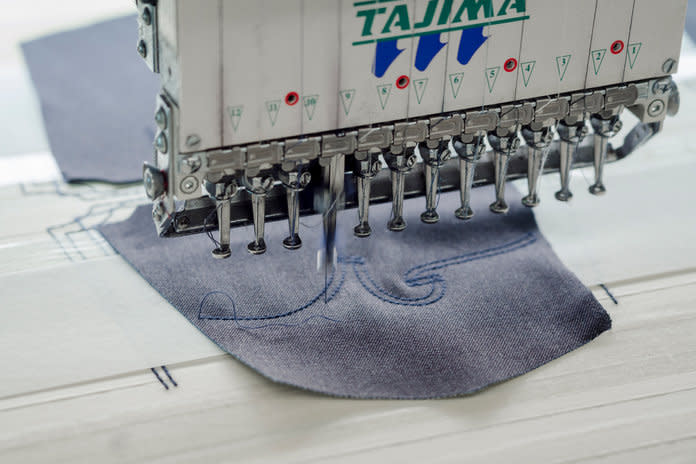
It's all in the details — in denim, as in sustainability.
|Philip Cheung
Can denim be even more earth-friendly?
For what Ley calls “a real closed-loop, circular model,” look to Netherlands brand Mud Jeans, which has offered jeans for rent since 2013. Once pants become worn-out, the brand recycles them into fresh pairs with tech from Jeanologia, a leader in denim-sustainability innovation.
Otherwise, this stuff just takes a lot of time, Dillinger says: “There’s often an appetite for instant innovation in the fashion industry, but the important solutions to the big problems required discipline and commitment, and they deserve our patience.” But there is a basic expectation to at least try to be better, Uddin says — and that’s a good thing for the fashion industry and increasingly eco-woke customers. “Operating in a sustainable manner is not a question of marketing or an attempt to increase sales; it is now becoming both a requirement of their end consumers,” he says. “Once people started speaking about it and spread awareness, machines, process and techniques were invented and practiced. This is a continued process: people are learning and adopting.”
The biggest learning is that each of us has a lot to lose. “We all need clean air and we all need to drink clean water, and there’s no single player in the industry big enough to solve the challenges of resource conservation on their own,” Dillinger, of Levi's, says. “We all need to get better at sharing the roadmap when we’ve achieved success — and sharing what we’ve learned from our failures.” But at least thanks to some of these enterprising brands, the outlook — and shoppers’ options — are pretty good. “I’m really hopeful,” says Wells of AG. “I don’t know many industries as polluting as apparel can be that have really looked at themselves and said, ‘How can we get better?’ and I think it’s happening across the board.”
